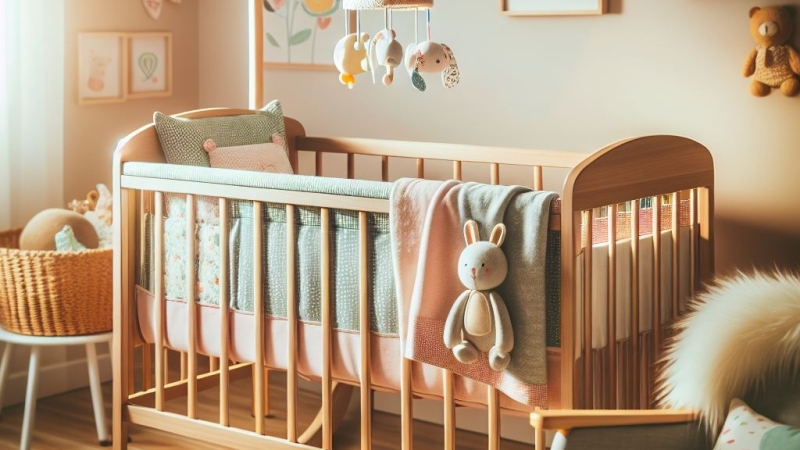07 Dec


0 Comment(s)
4722 View(s)
How to Choose the Best Baby Crib: Tips, Safety, and Regulations
Why is it Important to Choose the Right Baby Crib?
The crib is one of the first pieces of furniture your baby will use, and its safety and comfort are essential for their well-being. Choosing the right crib not only ensures a safe sleep but also creates a healthy environment where your baby can rest peacefully.
Here are some key tips and factors to consider when choosing the perfect crib for your baby.
Factors to Consider When Choosing a Baby Crib
- Safety First
Safety is the most important factor when choosing a crib. Make sure it meets current safety standards such as the UNE-EN 716:2017 regulations (safety standards for cribs and children's beds) and the CPSC (Consumer Product Safety Commission) guidelines. These standards ensure that the crib does not have parts that pose a risk to the baby, such as gaps in the bars that could cause suffocation. - Crib Safety Regulations
- UNE-EN 716:2017: This European standard regulates the safety of cribs and children's beds, setting requirements for structure, stability, bar spacing, and mattress height.
- UNE-EN 1130: This applies to cribs longer than 120 cm, providing additional specifications for structural safety and material strength.
- Regulation (EU) 2020/1149: This European legislation regulates standards for products that come into contact with children, ensuring that materials are non-toxic and that the crib meets safety standards.
- Crib Size
Standard cribs are approximately 120 x 60 cm, but there are also larger models (140 x 70 cm). If you have limited space, a smaller crib may be a better choice. If you have more space or plan to use the crib for longer, you can opt for a larger crib or a convertible crib that can be transformed into a bed as your child grows. - Materials and Construction
The crib should be made from high-quality materials, such as solid wood or good-quality MDF. The paint used should be non-toxic and free from harmful chemicals. Choose materials that are durable and easy to clean, as babies tend to get everything dirty. - Mattress
The mattress is one of the most important parts of the crib. Make sure it is firm to avoid suffocation risk or sudden infant death syndrome (SIDS). Additionally, the mattress should fit the crib perfectly without leaving gaps along the edges that could pose a risk. - Adjustable Mattress Height
Modern cribs offer the option to adjust the mattress height in several positions. This is a useful feature, as it allows you to keep the mattress higher when the baby is a newborn, making it easier to put them in and take them out of the crib. As the baby grows and starts trying to stand up, you can lower the mattress to avoid falls. - Convertible Crib
Convertible cribs are a popular option as they can transform into a toddler bed as the child grows. This allows you to make the most of the crib for a longer period, adapting to different stages of your baby's development. These cribs can transform from a 120x60 cm crib into a single bed, making it a more long-term investment. - Ventilation and Design
Ventilation is crucial, especially in warmer climates, to ensure proper airflow. Look for cribs with well-spaced bars and an open design that allows good airflow around the baby. Additionally, modern designs often include rounded corners to prevent accidents. - Easy Assembly and Maintenance
Ensure that the crib is easy to assemble and that the assembly instructions are clear. Additionally, it is important that the crib is easy to clean, as babies tend to make a mess. Make sure that components such as sheets, mattresses, and pillows are made from washable and easy-to-maintain materials.
What Type of Crib Should You Choose?
- Traditional cribs: These are standard wooden or metal cribs with bars around them. They are simple, safe, and durable.
- Convertible cribs: As mentioned earlier, these cribs can be transformed into beds for toddlers as your child grows.
- Co-sleeping cribs: These cribs are designed to sleep next to the parents' bed. They are perfect for mothers who want to keep their baby close during the early weeks.
- Travel cribs: Ideal for parents who need a portable option. They are lightweight and easy to transport but often less sturdy than traditional cribs.
Tips for Choosing the Best Crib
- Make sure the crib has all the safety certifications and complies with current legal standards.
- Think about long-term use. If possible, opt for a convertible crib that can be used as the child grows.
- Consider portability if you travel frequently or have a small home.
- Check reviews from other parents and look for recommendations on crib durability.
- Choose a crib that is aesthetically pleasing and matches the décor of the baby’s room.
Frequently Asked Questions (FAQ)
- At what age should I transition my baby from a crib to a bed?
- Typically, babies transition from a crib to a bed between the ages of 2 and 3 years, depending on their development and ability to move safely on their own.
- Is a crib with bars safe?
- Yes, cribs with bars are completely safe as long as they meet safety regulations, such as the appropriate bar spacing to avoid the baby getting stuck.
- Can I use the crib as a bed until my child is older?
- Some convertible cribs are designed to grow with your child and transform into a bed when the baby is older. However, most standard cribs are used only until around 3 or 4 years of age.
- What is the ideal mattress for a crib?
- The mattress should be firm, fit snugly in the crib, and be made from non-toxic materials. Make sure there are no gaps between the mattress and the crib bars.



